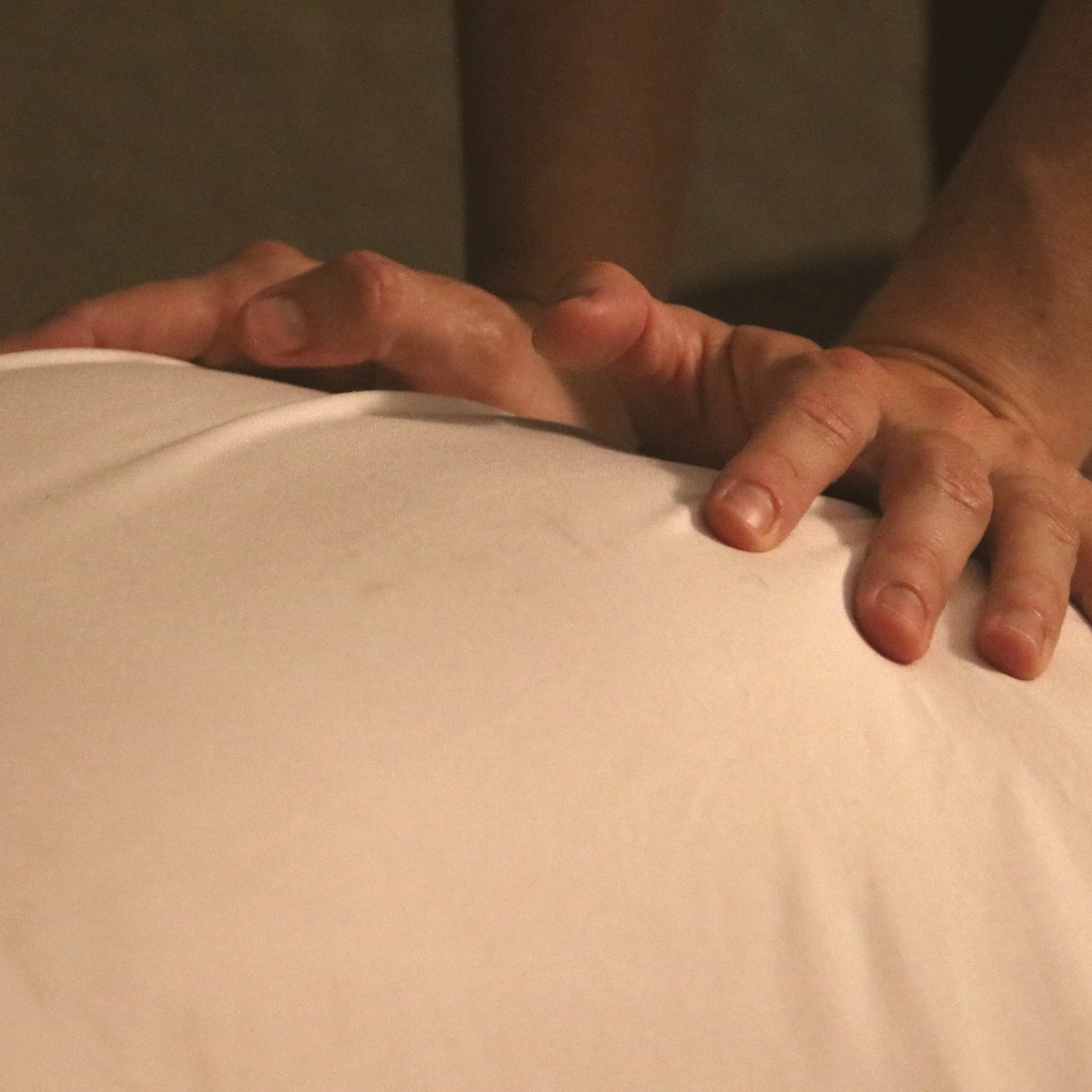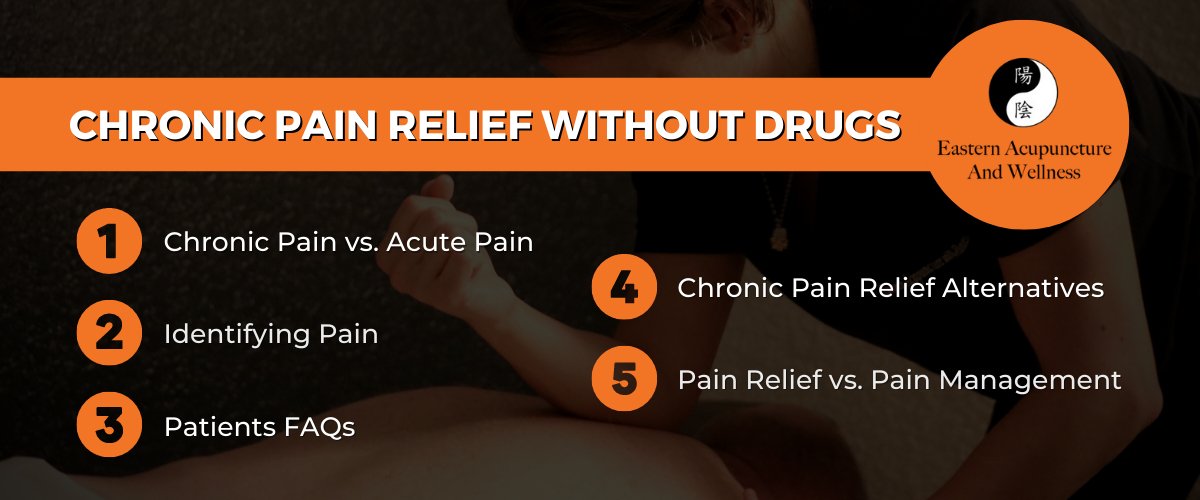Chronic pain is one of the most common reasons people seek medical help. It can be caused by a variety of issues, from an ongoing injury to conditions like fibromyalgia. For many people, medication is the only way to get relief from persistent pain. But what if there was another way? In this post, we'll explore some ways to get to the root of your pain and find chronic pain relief without the use of synthetic drugs.
This article is for information purposes only and should not be used as a replacement for professional medical advice. Our Physicians are Primary Care Doctors that specialize in East Asian Medicine. They are qualified to give this advice. However, if you are suffering from long-lasting pain, please consult with our Physicians before making any changes to your treatment regimen.
Differentiating Chronic Pain vs. Acute Pain
Lingering pain can have many causes, but often the main cause is deep-rooted. This can make finding definite pain relief a difficult and frustrating task. It’s important to understand that chronic pain is different from acute pain. Acute pain is a normal response to an injury or illness and typically goes away once the underlying problem is resolved. Chronic Pain, on the other hand, persists for weeks, months, or even years. An example is back pain that’s been present for longer than three months. It may be caused by an initial injury or illness, but it can also develop from other conditions like arthritis, fibromyalgia, or nerve damage.
Identifying Your Pain
If you’re struggling with persistent pain, it’s essential to see one of our Physicians to rule out any underlying medical conditions. Once any potential medical causes have been ruled out, you can begin to look for other possible triggers. Some standard pain signals include:
Stress: Chronic stress can lead to muscle pain and chronic headaches. It can also worsen conditions like fibromyalgia and irritable bowel syndrome.
Poor posture: Slouching or sitting in the same position for long periods can lead to back pain, neck pain, and other types of long-standing pain.
Obesity: Carrying excess weight puts extra strain on your joints and muscles, which can turn into pain.
Sleep problems: If you’re not getting enough sleep, your body can’t heal properly. This can lead to lingering pain.
Sedentary Lifestyle: Lack of exercise can create a myriad of issues, both physically and mentally.
3 Frequent Questions Patients Ask About Pain Relief Alternative Therapies
Deep-rooted pain can make it difficult to perform everyday activities, enjoy hobbies, and even get a good night’s sleep. It can stop you from living the life you want. That’s why many people are looking for alternatives to medication when it comes to chronic ache relief. Here are some of the most frequent questions people ask about natural and alternative techniques for relieving pain that is constant.
Why consider natural treatments over medication?
Consider trying pain relief alternatives like acupuncture, functional medicine, or massage therapy. These alternative treatments can help with progressive muscle relaxation, increase blood flow, and reduce inflammation. You can also try to relieve pain naturally with the help of herbal formulas and supplements like turmeric, ginger, or omega-3 fatty acids. These natural remedies can help to reduce inflammation and pain. Medications can have side effects, and many people prefer not to take them if they can avoid them. In many cases, it's beneficial to consider integrative techniques for your overall wellness.
How can you obtain pain relief with exercise?
You can make several lifestyle changes to help relieve the constant pain and inflammation. Exercise can help to increase blood flow and reduce inflammation. Yoga, Tai Chi, and other forms of gentle stretching can also help to relieve pain.
Why is it important to incorporate breathing techniques?
Your pain can also be caused by stress and anxiety. If you’re struggling with continuous pain, consider trying relaxation techniques like meditation or deep breathing exercises. Most of us do not realize that when we are in a stress response (fight or flight), we breathe more shallowly. This can tighten the muscles in the neck and shoulders, causing pain and even headaches.
6 Effective Chronic Pain Relief Alternatives To Consider
Once you’ve identified the possible causes of your pain, you can start working on finding relief. If you're one of the millions plagued by persistent pain, don't suffer in silence. There are many options for finding relief from your symptoms. Read on to learn more about the different types of treatments available.
1) Manual Therapy
One of the best things you can do for long-standing pain is to receive manual therapy. A manual therapist can help you stretch and strengthen the muscles that support your joints, which can help reduce pain. They can also teach you how to properly use assistive devices like canes and walkers if needed.
Manual therapies like trigger point therapy, deep tissue, reflexology, and lymphatic massage all help to “close the pain gate.” By stimulating the nerves and muscles, these therapies help to block pain signals from reaching the brain. As a result, you will experience relief from pain. In addition, manual therapies can also help improve circulation and relaxation. As a result, they can be an effective treatment for a variety of conditions, including headaches, back pain, and fibromyalgia.
2) Acupuncture
Acupuncture is a form of traditional Chinese medicine that involves inserting thin needles into the skin at specific points. This treatment is thought to stimulate the release of endorphins, which are natural painkillers. Acupuncture is commonly used to treat lower back pain, neck pain, arthritis, Fibromyalgia, dental pain, postoperative discomfort, headaches, and migraines, just to name a few.
3) Stress Management
Your pain can be exacerbated by stress, so it’s important to find healthy ways to manage stress. This can include things like yoga, meditation, and deep breathing exercises. Acupuncture is also an effective way to mitigate stress. Acupuncture puts you into a parasympathetic state, which allows the body to relax and repair.
4) Exercise
It may seem counterintuitive, but exercise is one of the best things you can do for relieving pain. Exercise releases endorphins to help reduce inflammation, and strengthens the muscles that support your joints.
If you’re struggling with continual pain, don’t lose hope. There are many things you can do to find relief. Talk to one of our Physicians about your treatment options and find the one that’s right for you.
5) Nutritional Therapy
What you eat can also influence pain reduction. A healthy diet full of fruits, vegetables, and whole grains can help reduce inflammation. Omega-3 fatty acids, found in fish like salmon and tuna, can also help reduce inflammation.
6) Dietary Supplements
Several dietary supplements may help with pain reduction. These include things like glucosamine, chondroitin, and curcumin, which is a compound found in turmeric, fish oil, and vitamin D. Herbs like ginger and garlic can also help to reduce inflammation.
Difference Between Pain Relief And Pain Management
It’s important to distinguish between pain relief and pain management. Pain relief is the goal of many treatments and typically involves reducing or eliminating the experience of pain. To eliminate aches without pain medication or surgery, pain relief treatments focus on finding the source of the pain and addressing it directly. Moreover, pain medicine is often used as a “Quick Fix” rather than a long-term management solution.
Pain management, on the other hand, has a broader focus and typically includes minimizing the impact of lingering pain on your quality of life. This may include things like identifying pain signals for your doctor and talking to your doctor about ways to minimize pain. Pain management may also include lifestyle modifications, such as exercising and getting enough rest.
Summary: How to get a handle on pain without medication?
Chronic aches are becoming common reasons for seeking medical treatment. Back problems in general affect everyone in our society. Mistreatment with opioids and some other prescription drugs makes it clear that other alternatives to pain-relief options must be available.
Today, you have access to professionals that can help identify your symptoms and come up with a natural treatment plan that eliminates pain without drugs via telemedicine. If you are not near Plantation or Wilton Manors, FL, you can still access our licensed practitioners virtually from anywhere. Check out what our patients have to say about us!
Data and studies
“Examined 16 review articles and 11 randomized controlled trials published in the last 5 years on the clinical efficacy of acupuncture in adults with CMP conditions. The available evidence suggests that acupuncture does have short-term pain relief benefits for patients that maintain regular treatment lasting relief, with symptomatic knee osteoarthritis and chronic low back pain, and is a safe and reasonable referral option. Acupuncture may also have a beneficial role for fibromyalgia”.
“The widespread use of opioids to treat chronic pain has led to an opioid epidemic characterized by exponential growth in opioid misuse and addiction. The staggering statistics related to opioid use highlight the importance of developing, testing, and validating fast-acting nonpharmacological approaches to treat pain. Mindfulness meditation is a technique that has been found to significantly reduce pain in experimental and clinical settings”.
“Journal of Alternative and Complementary Medicine in 2016 found that acupuncture was an effective treatment for chronic pain. Another study, published in the same journal in 2016, found that yoga was an effective treatment for chronic low back pain”.
Eastern Acupuncture And Wellness Plantation:
Eastern Acupuncture And Wellness Wilton Manors:
Resources
“Alternative Pain Relief.” Journal of Alternative and Complementary Medicine, vol. 22, no. 7, 2016, p. 561-568.
Zeidan F, Vago DR. Mindfulness meditation-based pain relief: a mechanistic account. Ann N Y Acad Sci. 2016 Jun;1373(1):114-27. doi: 10.1111/nyas.13153. PMID: 27398643; PMCID: PMC4941786.
Zhang Y, Wang C. Acupuncture and Chronic Musculoskeletal Pain. Curr Rheumatol Rep. 2020 Sep 25;22(11):80. doi: 10.1007/s11926-020-00954-z. PMID: 32978666; PMCID: PMC8719359.








